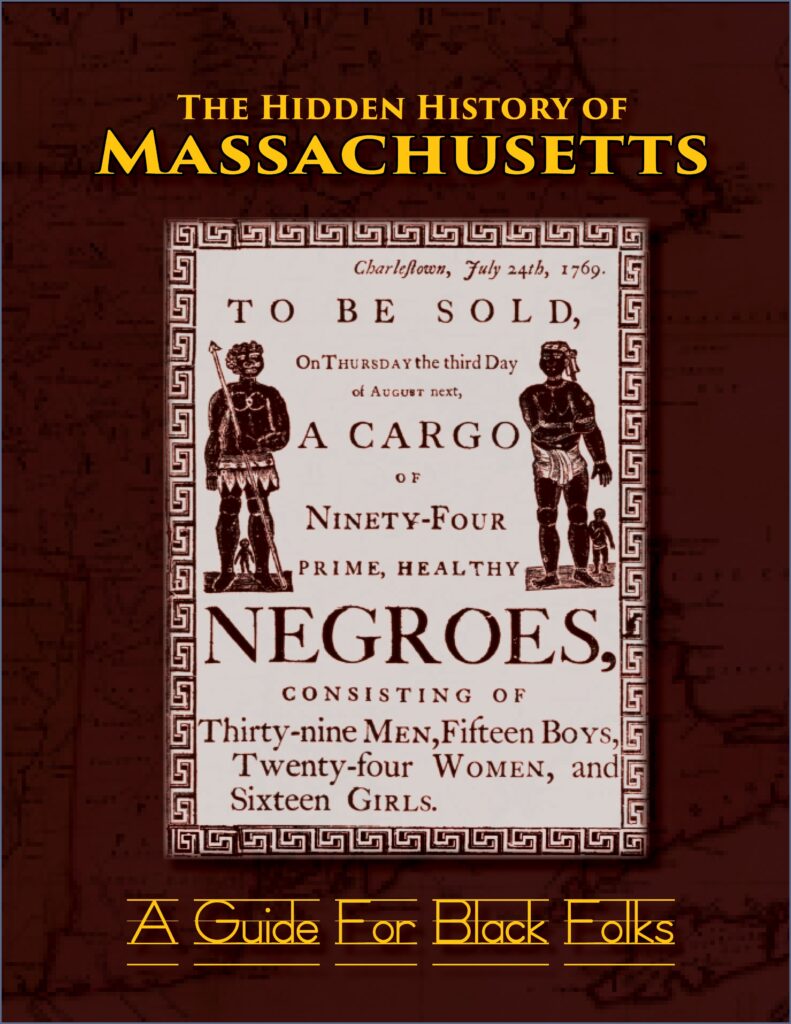White Robbery of the Massachusetts Indians
The master theft of Manhattan for what they now charge for 2-hours of parking your car was only the beginning. Read this excerpt from The Hidden History of Massachusetts: A Guide for Black Folks.
…From their ships casing the Atlantic coastline, the early European explorers, exploiters, and robbers reported great expanses of cultivated land expertly planted with corn, peppers, strawberries, beans, squashes, artichokes, grapes, and tobacco, with structures for their long-term storage. The Indians rotated crops and used various means of fertilization to enhance their yields. The forests were described as “parklike,” with the underbrush cleared away by controlled burning for easy foot travel and efficient hunting. The original occupants had implemented a land-management policy that respected nature and kept all of the inhabitants well fed and yet maintained a balanced population of wildlife.
When the white men stumbled ashore they found among the natives expert leather craftsmen, potters, culinary artists, herbalists, weavers, woodworkers, and highly skilled hunters and trappers. Indian hunters had planted hedges in such a manner as to direct game into their traps. They kept wild salmon as fresh as possible by way of a device which used the river current to turn a wheel that gently scooped out migrating fish and deposited them live in an enclosed pool until dinner-time. The women could clear a field for planting, using fire as a tool, faster than many men with axes. They used woven bas-kets for storing corn, some constructed so skillfully they could carry water in them.
The Europeans found a welcoming, friendly, and gentle people, numbering in the hundreds of thousands, members of a well-ordered agrarian society with a solid political, social, and spiritual structure and strong alliances with other Indian communities. They found an Indian Constitution by which Indian society was managed (with women holding a position of high respect in governance), and which would eventually form the foundation of the white man’s American Constitution more than a century and a half later.
They found no jails, no forts, no starvation, no native diseases that were not treatable or even curable by the medical experts among the Indians. And they found a practice unknown in Europe: the native people meticulously bathed everyday…
In Massachusetts and all over the Americas the Indians’ concept of ownership was profoundly different from that of the whites. To Indians, an individual could not “own” or “possess” an item he did not create with his own hands, or an object he could not pick up and carry away. Land was a creation of the Supreme Being—a sacred gift that the Indians managed on behalf of themselves and future generations. This theme is repeated in the Indian practice of Seventh Generation philosophy—that is, the measuring of every thought, word, and deed for its effect on their descendants seven generations into the future. The pristine state of the natural environment at the time of the European invasion—after tens of thousands of years of Indian habitation—is irrefutable evidence of Indian commitment to this practice.
Europeans had their own “land management” philosophy: invade the indigenous communities, murder the inhabitants, snatch the land, exploit its riches, and leave their own children and grandchildren (and those of everyone else) to pick through the rubbish. After a single generation of white “stewardship” over the land, the Massachusetts landscape had become unrecognizable. And today, most species of game have disappeared, their habitats now strip malls and parking lots, the air a noxious concoction of fumes and gases, the water a poisonous sludge.
Early Massachusetts whites used numerous methods to steal Indian land:
• Whites would allow their livestock to trample and eat an Indian’s crops until he, having no recourse, moved off his own land. Even when the Indian uncharacteristically fenced in his cropland, he found that the whites would simply destroy his wall. The Indian would not dare kill a white man’s animals, even in self-protection and even though whites often killed the livestock of the Indians.
• White men would take advantage of the fact that Indians moved to various settlements in different seasons to take advantage of animal migrations, fish runs, or fertile land. In their absence, whites would claim that the “nomadic” “wandering” Indians abandoned their settlements and would forcibly take over the land.
• White men would threaten bodily harm to the Indian who owned the land, forcing him to deed over the land; he was then sometimes permitted to remain as a tenant on a corner of the land he formerly had owned. [Whites used this method of terror against Blacks late into the 1900s.]
• Whites would impose outrageous fines for a wide variety of arbitrary offenses—the Indian’s lands forfeited if the fines were not paid by their due date. The offenses ranged from curfew violations to conspiracy against English rule. An Englishman would “rescue” him by paying his fine for a short-term mortgage on his land and later foreclosing. The whole town of Dorchester was stolen by this very method—the “offense” being perhaps “traveling on the Sabath.”
• Whites counterfeited the Indian currency, for the purpose of defrauding the Indians of their land. In 1630 John Winthrop actually brought the counterfeit money with him from England for that purpose.
If an Indian ever took his grievance to an English court, the proceedings would simply confirm the legality of the theft. READ MORE in The Hidden History of Massachusetts: A Guide for Black Folks.
